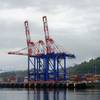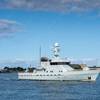Draft amendments to revise the MARPOL regulations on the prevention of air pollution from ships were agreed by the IMO Sub-Committee on Bulk Liquids and Gases (BLG) when it met last week (4-8 February) for its 12th session.
Following lengthy and technically challenging discussions in the Air Pollution Working Group, the Sub-Committee agreed a draft revised Annex VI to the MARPOL Convention and amendments to the NOx Technical Code. These will now be submitted to the Marine Environment Protection Committee (MEPC), which meets for its 57th session from 31 March to 4 April 2008.
A number of options remain open for discussion at the MEPC, which is expected to approve the amendments prior to their formal adoption at MEPC 58 (6 to 10 October 2008). The amendments would then enter into force, under the tacit acceptance procedure, 16 months later, in March 2010, or on a date to be decided by the MEPC.
SOx and PM Emissions
Given the significant environmental, human health, and economic consequences of a decision on how best to further reduce emissions of sulphur oxide (SOx) and particulate matter (PM) from ships, the Sub-Committee felt it appropriate that relevant policy decisions should be taken at the Committee level and that its principal duty was to "set the table" for such discussions.
The comprehensive report by the informal Cross Government/Industry Scientific Group of Experts, established, following an initiative by IMO Secretary-General Efthimios E. Mitropoulos, to evaluate the effects of the different fuel options proposed under the revision of MARPOL Annex VI, together with the outcome of the intersessional meeting of the Air Pollution Working Group held in Berlin in October/November 2007, enabled the BLG Sub-Committee to make significant progress.
The Working Group was tasked with reviewing the six options under consideration and, following extensive discussion in the group, the BLG Sub-Committee agreed to reduce the six options to just three, representing an equitable and fair compression of the different concepts and proposals under consideration by the Organization, as described below (the figures in square brackets remain open for further consideration by the MEPC):
Option 1 Global
1.00% (10,000 ppm)* fuel standard applied globally in [2012]
0.50% (5,000 ppm) fuel standard applied globally in [2015]
Option 2 Global / Regional
Global cap remains unchanged at 4.50% (45,000 ppm)
Emission Control Areas require 0.10% (1,000 ppm) standard in [2012]
Option 3 Global / Regional with Micro-Areas
Global cap is lowered to 3.00% (30,000 ppm) in [2012]
Emission Control Area standard lowered to 1.00% (10,000 ppm) in [2010]
Emission Control Area standard lowered to 0.50% (5,000 ppm) in [2015]
Micro-Emission Control Areas may be established at a distance of no more than 24 nautical miles from the baseline with a 0.10% (1,000 ppm) standard. A proposal for such Micro-Emission Control Areas must be submitted to the IMO for review, but are to be subject to a relaxed set of criteria.
* The respective parts per million (ppm) and corresponding percentages all refer to maximum sulphur content limits.
These three options have now been put forward by the Sub-Committee to the MEPC. It was noted that the respective implementation dates, control levels, and concepts outlined in the above options would all be subject to debate and modification and that nothing precluded the development of a hybrid proposal.
A concern was raised over whether sufficient quantities of compliant fuel would be available to support the options as presented. As initially presented, all options would require significant changes in product output from many refineries around the world, with some options representing an unprecedented single step regulatory change compared to the changes that have driven global fuel markets in the past decade.
Particular attention was drawn to the need to maintain the production link between marine fuel and land-based fuel with respect to specifications around the world and to adopt a phased approach such that refinery and supply configurations could be adapted, in response to market signals, to ensure continued availability and supply without major disruption.
A number of other matters were also addressed, including finalization of draft exhaust gas cleaning guidelines and wash water discharge criteria for such systems, to be forwarded to MEPC for discussion and possible adoption by the Committee. It was, however, decided not to recommend that a market-based instrument or trials for such instruments be included in the amendments to Annex VI.
NOx Regs for New Engines
The Sub-Committee further developed the three-tier structure for new engines, which would set progressively tighter nitrogen oxide (NOx) emission standards for new engines depending on the date of their installation. Tier I represents the 17 g/kW standard stipulated in the existing Annex VI.
For Tier II, it was agreed to recommend a standard that would see NOx emission levels for new engines installed from 1 January 2011 reduced by a figure of between 15.5 per cent and 21.8 per cent, depending on the engine's operating parameters.
With regard to Tier III, a number of delegations expressed the view that a geographically based approach requiring significant reductions in designated Emission Control Areas (ECAs), should be introduced. Such an approach, it was felt, would provide a global framework for reducing NOx emissions in coastal areas with the most severe problems, while allowing operation at the Tier II level outside the designated Emission Control Areas. It was also noted that this approach would offer significant protection of the environment and human health, while avoiding the increased fuel consumption that is associated with less advanced NOx reduction technologies.
The recommended Tier III standard, applicable to new builds beginning on 1 January 2016, will, therefore, see a reduction of 80 per cent from Tier I levels in specific emission control areas designated through IMO. The Organization will develop guidelines for the designation of such areas, taking into account the environmental impact. The meeting noted that engine manufacturers in Japan are already developing advanced engine treatment systems to meet the proposed Tier III standard.
NOx Standards for Existing Engines
The working group reviewed the issue of whether it was appropriate and feasible to establish a standard applicable to pre-2000 marine diesel engine installations. While a wide range of opinion exists on the question of whether such a standard is appropriate and practical, many delegations felt that insufficient information and studies had been submitted to inform such a decision. It was, therefore, agreed that further information and consideration of this matter will be necessary at MEPC 57.
NOx Technical Code
With respect to the NOx Technical Code, earlier debates concerning the certification of serially produced engines, direct measurement and monitoring methods, a draft certification procedure for existing engines, and test cycles to be applied to Tier II and Tier III engines, were resolved. Among other things, it was agreed that it should be left to the Administration to decide whether serially produced engines will be required to be certified individually, and that each engine should be accompanied throughout its life installed on a ship, while under the authority of a given Administration, by a certificate demonstrating its conformity as part of a generic engine family certification or a certificate issued for that single engine.
Draft text for chapter 6.4 of the NOx Technical Code concerning direct measurement and monitoring was further developed and agreed, and test cycles to be applied for the Tier II and Tier III NOx standards were also agreed. It was, however, recognized that the test cycle and respective load points may be revisited in the future, if necessary.
Speaking at the close of the session, Secretary-General Mitropoulos highlighted the importance of this work for the wider maritime community and for the environment and praised the working group for "successfully conducting strenuous negotiations into the small hours during the week, in order to build a consensus reconciling the various positions."
He told delegates "draft amendments to MARPOL Annex VI and the NOx Technical Code can now go forward to the Committee, for it to make the sound and well-informed decisions - with the benefit of your advice and within the agreed timelines - that the international maritime community so eagerly expects and the environment deserves." He urged all IMO Members to reconvene at MEPC 57 with the high resolve and enthusiasm that had been shown throughout this meeting, so that, "the IMO spirit of co-operation may prevail and facilitate the fulfilment of the goals we have so diligently pursued since 2005, when the revision process was set in motion."
Featured videos

Inside the Electrified Truckable Tug

Tracking Foreign Vessels Working in the U.S. Jones Act Market

Unlock Onboard Data Efficiencies
Subscribe for
Maritime Reporter E-News
Maritime Reporter E-News is the maritime industry's largest circulation and most authoritative ENews Service, delivered to your Email five times per week









